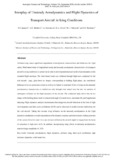JavaScript is disabled for your browser. Some features of this site may not work without it.
| dc.contributor.author | Ignatyev, Dmitry I. | |
| dc.contributor.author | Khrabrov, Alexander N. | |
| dc.contributor.author | Kortukova, A. I. | |
| dc.contributor.author | Alieva, D. A. | |
| dc.contributor.author | Sidoryuk, Maria E. | |
| dc.contributor.author | Bazhenov, Sergey G. | |
| dc.date.accessioned | 2020-07-01T09:01:19Z | |
| dc.date.available | 2020-07-01T09:01:19Z | |
| dc.date.issued | 2020-06-11 | |
| dc.identifier.citation | Ignatyev DI, Khrabrov AN, Kortukova AI, et al., (2020) Interplay of unsteady aerodynamics and flight dynamics of transport aircraft in icing conditions. Aerospace Science and Technology, Volume 104, September 2020, Article number 105914 | en_UK |
| dc.identifier.issn | 1270-9638 | |
| dc.identifier.uri | https://doi.org/10.1016/j.ast.2020.105914 | |
| dc.identifier.uri | https://dspace.lib.cranfield.ac.uk/handle/1826/15520 | |
| dc.description.abstract | Airframe icing causes significant degradation of aerodynamic characteristics and influences the flight safety. Wind tunnel study of longitudinal steady and unsteady aerodynamic characteristics of a transport aircraft in icing conditions is carried out in order to develop mathematical model of aerodynamics in the extended flight envelope. The wind tunnel results are validated through flight tests conducted for the real aircraft. Large, glaze-horn ice shapes, corresponding to holding flight phase, are considered. Influence of an ice protection system as well as its failure is examined. Effect of icing on the unsteady aerodynamics characteristics is studied not only through wind tunnel tests but also via analysis of subsequent influence on the flight dynamics of the aircraft. The conducted study shows that the ice shapes of the holding phase leads to reduced stall angle of attack (AoA), maximum lift, and longitudinal damping. Flight dynamics analysis demonstrates that dangerous aircraft behaviour in the form of high AoA departure and limit cycle oscillations (LCO) can be observed at smaller elevator deflections for the iced aircraft. Taking into account icing influence on the unsteady aerodynamics in the flight dynamics simulations revealed degradation of the dynamic response and deterioration of phase portraits of the system. Even for small AoA and elevator deflection the aircraft might be trapped into the basin of attraction of high-AoA LCO. In addition, incorporating icing effects in unsteady aerodynamics manifest larger amplitude of LCO. | en_UK |
| dc.language.iso | en | en_UK |
| dc.publisher | Elsevier | en_UK |
| dc.rights | Attribution-NonCommercial-NoDerivatives 4.0 International | * |
| dc.rights.uri | http://creativecommons.org/licenses/by-nc-nd/4.0/ | * |
| dc.subject | wind tunnel test | en_UK |
| dc.subject | high incidence departure | en_UK |
| dc.subject | limit cycle oscillations | en_UK |
| dc.subject | airframe icing | en_UK |
| dc.subject | flight dynamics | en_UK |
| dc.subject | Unsteady aerodynamics | en_UK |
| dc.title | Interplay of unsteady aerodynamics and flight dynamics of transport aircraft in icing conditions | en_UK |
| dc.type | Article | en_UK |
| dc.identifier.cris | 26788018 | |
| dc.date.freetoread | 2021-06-12 |
Files in this item
The following license files are associated with this item:
This item appears in the following Collection(s)
-
Staff publications (SATM) [4468]

